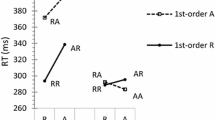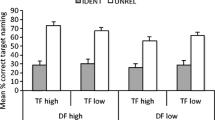Abstract
Repetition-priming effects were investigated with a speeded verification task as an indirect or implicit test. Subjects were asked to verify whether items were instances of the categories “first name” and “profession.” In Experiment 1, instances were repeated in their alternate gender form (e.g., PAUL as PAULA, or WAITRESS as WAITER) and performance was compared to new instances. Facilitation in terms of faster response latencies for old instances (i.e., repetitions in the alternative gender form) was restricted to the category “profession.” In Experiment 2, facilitation was found for names studied and tested in the same gender form (e.g., PAUL-PAUL). Instances of professions were repeated in either the same or the alternative gender form; the amount of facilitation was identical for the two repetition conditions. However, transfer across gender forms was affected by the study-test order (facilitation was larger from male to female than from female to male) and by the gender dominance of specific instances. In Experiment 3, the interfering effect of gender dominance was not replicated. Response accuracy tended to parallel the latency results in all experiments, but without reaching statistical reliability. Therefore, the faster response latencies for old items are by no means the result of a speed-accuracy trade-off. The central finding of the experiments reported is the material-dependent dissociation of repetition transfer across gender forms that occurred for instances of professions, but was absent for names. This dissociation is interpreted to indicate that the stimulus-driven speeded verification test is sensitive to conceptual, but not to perceptual, processing aspects of a study event.
Similar content being viewed by others
References
Brooks, L. R. (1978). Non-analytic concept formation and memory for instances. In E. Rosch & B. B. Lloyd (Eds.), Cognition and categorisation (pp. 169–211). Hillsdale, NJ: Erlbaum.
Brooks, L. R. (1987). Decentralized control of categorization: the role of prior processing episodes. In U. Neisser (Ed.), Concepts and conceptual development: Ecological and intellectual factors in categorization (pp. 141–147). Cambridge, England: Cambridge University Press.
Brooks, L. R., Norman, G. R., & Allen, S. W. (1991). Role of specific similarity in a medical diagnostic task. Journal of Experimental Psychology: General, 120, 278–287.
Graf, P., & Schacter, D. L. (1985). Implicit and explicit memory for new associations in normal and amnesic subjects Journal of Experimental Psychology: Learning, Memory, and Cognition, 11, 501–518.
Graf, P., Shimamura, A. P., & Squire, L. R. (1985). Priming across modalities and across category levels: Extending the domain of preserved function in amnesia. Journal of Experimental Psychology: Learning, Memory, and Cognition, 11, 386–396.
Hamann, S. B. (1990). Level-of-processing effects in conceptually driven implicit tasks. Journal of Experimental Psychology: Learning, Memory, and Cognition, 16, 970–977.
Jacoby, L. L. (1978). On interpreting the effects of repetition: Solving a problem versus remembering a solution. Journal of Verbal Learning and Verbal Behavior, 17, 649–667.
Jacoby, L. L. (1983). Remembering the data: Analyzing interactive processes in reading. Journal of Verbal Learning and Verbal Behavior, 22, 485–508.
Jacoby, L. I., (1991). A process dissociation framework: Separating automatic from intentional uses of memory. Journal of Memory and Language, 30, 513–541.
Jacoby, L. L., & Brooks, L. (1984). Nonanalytic cognition: Memory, perception and concept learning. In G. H. Bower (Ed.), The Psychology of learning and motivation: Advances in research and theory (Vol. 18, pp. 1–47). San Diego, CA: Academic Press.
Morger, V. (1990). Wiederholungs-Effekte bei Kategorie-Verifikationen. (Repetition effects in categorization,) Unpublished dissertation, University of Bern.
Morger, V. (1994). Nonanalytic procedures in verifying exemplars of well-defined concepts: Even and odd numbers. German Journal of Psychology, 18, 28–30.
Morris, C. D., Bransford, J. D., & Franks, J. J. (1977). Levels of processing versus transfer appropriate processing. Journal of Verbal Learning and Verbal Behavior, 16, 519–533.
Murrell, G. A., & Morton, J. (1974). Word recognition and morphemic structure. Journal of Experimental Psychology, 102, 963–968.
Rajaram, S., & Roediger, H. L. (1993). Direct comparison of four implicit memory tests. Journal of Experimental Psychology: Learning, Memory, and Cognition, 19, 765–776.
Richardson-Klavehn, A., & Bjork, R. A. (1988). Measures of memory. Annual Review of Psychology, 39, 475–543.
Roediger, H. L., & McDermott, K. B. (1993). Implicit memory in normal human subjects. In H. Spinnler & F. Boller (Eds.), Handbook of neuropsychology (Vol, 8, pp. 63–131). Amsterdam: Elsevier.
Roediger, H. L., Weldon, M. S., & Challis, B. H. (1989). Explaining dissociations between implicit and explicit measures of retention: A processing account. In H. L. Roediger, & F. I. M. Craik (Eds.), Varieties of memory and couneiousness: Essays in honour of Endel Tulving (pp. 3–41). Hillsdale, NJ: Erlbaum.
Schacter, D. L. (1987). Implicit memory: History and current status. Journal of Experimental Psychology: Learning, Memory, and Cognition, 13, 501–518.
Schneider, W. (1988). Micro experimental laboratory: An integrated system for IBM PC compatibles. Behavior-Research-Methods, -Instruments, and -Computers, 20, 206–217.
Srinivas, K., & Roediger, H. L. (1990). Classifying implicit memory tests: Category association and anagram solution. Journal of Memory and Language, 29, 389–412.
Tulving, E. (1983), Elements of episodic memory. New York: Oxford University Press.
Woltz, D, J. (1990). Repetition of semantic comparisons: Temporary and persistent priming effects. Journal of Experimental Psychology: Learning, Memory, and Cognition, 16, 392–403.
Author information
Authors and Affiliations
Rights and permissions
About this article
Cite this article
Morger, V. Does PAULA prime PAUL? Does WAITER prime WAITRESS? Implicit transfer across gender forms of verbal stimuli. Psychol. Res 57, 229–241 (1995). https://doi.org/10.1007/BF00431284
Issue Date:
DOI: https://doi.org/10.1007/BF00431284




